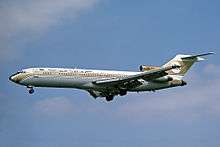Libyan Arab Airlines Flight 1103
Libyan Arab Airlines Flight 1103 was a Boeing 727-2L5[note 1] with 10 crew and 147 passengers on board that collided with a Mikoyan-Gurevich MiG-23 on 22 December 1992. All 157 people onboard flight 1103 were killed, while the crew of the MiG-23 ejected and survived. It was the deadliest aviation disaster to occur in Libya at the time.[1]
| Accident | |
|---|---|
| Date | 22 December 1992 |
| Summary | Mid-air collision (disputed) |
| Site | near Tripoli International Airport, Tripoli, Libya |
| Total fatalities | 157 |
| Total survivors | 2 |
| First aircraft | |
 5A-DIA, the Boeing 727 that crashed, in 1978 | |
| Type | Boeing 727-200 |
| Operator | Libyan Arab Airlines |
| Registration | 5A-DIA |
| Flight origin | Benina International Airport |
| Destination | Tripoli International Airport |
| Passengers | 147 |
| Crew | 10 |
| Fatalities | 157 |
| Survivors | 0 |
| Second aircraft | |
| Type | Mikoyan-Gurevich MiG-23 |
| Operator | Libyan Air Force |
| Registration | Unknown |
| Crew | 2 |
| Fatalities | 0 |
| Survivors | 2 (all) |
Crash
On 22 December 1992 Flight 1103 took off from Benina International Airport near Benghazi on a domestic flight to Tripoli International Airport. At an altitude of 3,500 ft (1,070 m) during the Boeing 727's approach to Tripoli airport, the aircraft collided with an Mikoyan-Gurevich MiG-23 and disintegrated, resulting in the death of all 157 passengers and crew.[2] The two crew members of the MiG-23 ejected before impact and survived.
Investigation and aftermath
The official explanation and air accident investigation report both blamed a collision with a Libyan Air Force MiG-23; the pilot and instructor of the MiG were imprisoned.[3][4]
After the crash, a spokesman for the Libyan Civil Authority stated he had been forbidden from releasing any information about the crash, including which planes had been involved.[5] A mass grave was prepared for the victims outside of Tripoli with poor international relations denying the bodies of international victims being returned to their families.[6]
Twenty years later, after the fall of Muammar Gaddafi, Abdel Majid Tayari, the instructor in the MiG-23 aircraft, challenged the official version of events, claiming that Flight 1103 was deliberately destroyed, because he saw its tail falling before his aircraft suffered a strong impact (from either the shock wave of the explosion that destroyed the Boeing 727 or a piece of wreckage) and he was forced to eject from his aircraft along with his trainee.[7] In a statement Majid Tayari claims there was no air collision, but conceded that the planes were too close to one another.[8]
Ali Aujali, who served as a Libyan diplomat both under Gaddafi and under the National Transitional Council, claims that Gaddafi ordered that the Boeing 727, whose flight was assigned the number 1103, be shot down exactly four years to the day after the bombing of Pan Am Flight 103 in order to demonstrate the negative effects of international sanctions imposed on Libya. According to Aujali, the dictator originally ordered a bomb with a timer to be in the aircraft, but when this failed to explode, he "ordered the [aircraft] to be knocked out of the sky".[9] The widow of one British victim has claimed Libyan families of victims had asked if she had tested her husband's passports for explosive residue.[10] Numerous theories follow the idea that Gaddafi had a hand in the crash, with claims that Gaddafi exploited the accident and used it as propaganda against sanctions from the Pan Am Flight 103 crash.[11]
Memorials
The first memorial for the crash was held near Tripoli, Libya in 2012.[10] The ceremony was attended by families and friends of the victims, and politicians.[12]
See also
Notes
- The aircraft was a Boeing 727-200 model; Boeing assigns a unique code for each company that buys one of its aircraft, which is applied as an infix to the model number at the time the aircraft is built, hence "727-2L5" for a Boeing 727-200 built for Libyan Arab Airlines.
References
- "Boeing 727 Crashes in Libya". Flight International, 6–12 January 1993. p. 8.
- Ranter, Harro. "Aircraft accident Boeing 727-2L5 5A-DIA Tripoli International Airport (TIP)". aviation-safety.net. Aviation Safety Network. Retrieved 24 April 2010.
- Sharqieh, Ibrahim (December 2013). "Reconstructing Libya: Stability Through National Reconciliation" (PDF). Brookings Doha Center Analysis Paper: 1–41.
- "Collision report between Libyan Arab Airlines Boeing 727-200 (5A-DIA) and military aircraft MiG-23 (8428 on 22 December 1992, near Tripoli International Airport" (PDF). caa.ly (in Arabic). Libyan Civil Aviation Authority. Archived from the original (PDF) on 21 March 2016. Retrieved 21 September 2019.
- Simpson, Paul (2014). The Mammoth Book of Air Disasters and Near Misses. London: Robinson. ISBN 978-1780338286.
- "Libyan jet crashes, killing 158, apparently after mid-air collision". UPI. Retrieved 28 May 2018.
- El Shammaa, Dina (18 June 2011). "Victim's wife wants Gaddafi tried for role in 1992 aircraft collision". Gulf News. Archived from the original on 30 May 2018. Retrieved 28 May 2018.
- Campbell, Glenn (4 January 2013). "Calls to re-open Libya plane 'crash' investigation". BBC News. BBC.
- "'No mid-air collision' in 1992 Libya air disaster". HeraldScotland. Retrieved 28 May 2018.
- Olgiati, Christopher (2 February 2014). "Libya: Muammar Gaddafi's secrets finally revealed". BBC News. BBC. Retrieved 2 February 2014.
- Borland, Ben (22 July 2012). "Tests could reveal Gaddafi bomb plot". Express.co.uk. Retrieved 28 May 2018.
- "Flight 1103". www.aljazeera.com. Retrieved 28 May 2018.
- "20 years on, families want truth of 'Libyan Lockerbie'". MoroccoWorldNews (in Arabic). Retrieved 28 May 2018.